 It is always a joy to visit the Louvre. My first two visits to the museum were quick and rushed. I did learn my lesson so on my third visit to Paris, I set aside one day just for the Louvre. It was such a wonderful experience!
It is always a joy to visit the Louvre. My first two visits to the museum were quick and rushed. I did learn my lesson so on my third visit to Paris, I set aside one day just for the Louvre. It was such a wonderful experience! I got to the museum just 10 minutes after its opening time but there were lots of people already queued up for the security check. I was doing a leisurely walk on Champs Elysees earlier that morning before I went to visit the Louvre to kill time. However, seeing the long line that early made me realize I should have gone straight to the museum from the hotel instead.
Not caring about the long lines, I lingered in front of this iconic I. M. Pei designed Pyramide du Louvre and imagining what it was like to unveil this large metal and glass pyramid in front of critical eyes around the world. For me, it was an instant hit. I love it! It compliments the Baroque buildings adding a contemporary element to the entire complex. It is also a great focal point.
Luckily, the lines went fast and I was at the museum lobby ticketing in no time. It had been over ten years since the last time I was at the museum and I have a faint memory of how truly wonderful this lobby is. I lingered here once again but this time I made sure I admired every inch of the interior and taking as much pictures as I could while imagining its design process.
You can picture the museum building is U-shaped since it used to be one of the royal's palaces before it got turned into a museum. From the museum lobby there are three entrances, one for each wing - the Denon entrance which leads to the Denon wing and the Richelieu entrance which leads into the Richelieu wing and then the Sully entrance to the Sully wing. I love how the natural lights create these amazing colors.
Armed with this electronic audio guide that the museum rents out for a small fee, I carefully planned my day at the Louvre and decided to take the Denon entrance.
The museum is huge so careful planning is crucial and I knew that six hours were not going to be enough time to see the entire collection on display. The first on my list that day was the Sculptures of Europe.
The sculpture on the left is called Le Temps Découvrant la Vérité et Les Arts by Honore Pelle. The one on the right is called Apollon Vainqueur Du Serpent Python. The sculptor is not indicated in the plate but it does say that it is Italian in origin and dates back to early 8th century. I found it challenging to take this photo because of the natural lights from the windows behind the sculptures and flash photography is not allowed. These sculptures are not necessarily my favorites but I was drawn to them because of their exquisite details.
Here are the sculptures by Michelangelo and I can say they are my favorites. The one on the left is called L'Esclave Rebelle and the one on the right is called L'Esclave Mourant. Compared to the other sculptures in the museum, these Michelangelo sculptures look unfinished and yet they are evocative and intriguing.
Here is another view of Michelangelo's sculptures. I had seen another popular male nude sculpture made by Michelangelo called David during a previous trip to Florence and I can see similarities among these masterpieces. His exquisite creations showcase the male body beautifully and represent that we are created in God's image.
On the same floor as Michelangelo's sculptures, another favorite of mine is the Aphrodite, known as the Venus de Milo sculpture. I learned that it was unearthed in 1820 on the island of Melos. I had a challenging time taking this picture because of the thick crowd gathered around it and it never thinned out.
Another one of my favorite sculptures is the Winged Victory of Samothrace or Nike of Samothrace. I learned that it was created around 190 BC and it was unearthed in the 1800s by Charles Champoiseau on the small island of Samothrace in Greece. I love that this sculpture was put in this part of the museum so that it becomes a focal point when coming up the stairs.
I always see a big crowd gathering around this celebrated sculpture during my visits to the museum. Looking at the sculpture on all sides, I could see the perceived movement in the way the draped dress is flowing and how the wings are angled.
Here is another view showing different parts of the dress and the left wing.
Here is another view where shadows help emphasize the movement.
I've seen this sculpture a couple of times but I don't remember seeing it from different sides. Seeing this beauty from all possible sides gave me more appreciation of this masterpiece.
I've seen this sculpture a couple of times but I don't remember seeing it from different sides. Seeing this beauty from all possible sides gave me more appreciation of this masterpiece.
Here is an iPhone view with some museum goers included in the background.
Not far from the Winged Victory of Samothrace is the fully packed Room 711 where, possibly the most important art work in the world, La Gioconda is on display. The portrait painted by Leonardo Da Vinci is popularly known as The Mona Lisa. It is the smaller painting on the right side of the picture below.
It is actually easy to find in which room the Mona Lisa is located despite the massive and labyrinth-like museum the Louvre is. Just follow the folks walking fast to the point of running. More often than not, they are tourists in Paris who are just going to be in and out of the museum. How do I know? I was one of them many years ago. There is even an MIT study that keeps track of visitor behavior inside the Louvre where it shows that there are visitors who only see the more popular art works in the museum and the Mona Lisa is one of them.
It was overwhelming at first because seeing the Mona Lisa upclose seemed like an impossible task judging by the amount of people inside Room 711. However, if you linger and just stand among the crowd, you can slowly inch your way to the front without resorting to elbowing fellow museum guests. Just remember that people stand behind the velvet rope.
I learned that the model is thought to be someone named Lisa Gherardini who was the wife of a Florentine merchant named Francesco del Giocondo - that is why the La Gioconda title. The first time I saw the Mona Lisa, I did not expect it to be that moderate in size. I had imagined it to be a huge painting that almost covered the wall where it is hanging. How could a painting this size have captured the hearts of everyone who had seen it, including mine? It must be her quintessential smile!
Zooming in on the Mona Lisa. This was my third time to see the Mona Lisa and the experience was as good as the first one.
Also on display in Room 711 is this huge painting called The Wedding Feast at Cana by Paolo Veronese. If you are not familiar with the Biblical story, this was where Christ was invited to a wedding feast and where he turned water into wine. Of course, the painting seems to depict more of a fashionable Venetian wedding scene than the Biblical one. I see similarities to the artist's art work housed at the Galeria dell'Accademia in Venice called The Feast at the House of Levi in terms of the level of detail depicted in the painting.
Here is another painting by Leonardo Da Vinci called The Virgin Of The Rocks which is on display in the adjacent room from the Mona Lisa. In the painting, the Virgin Mary, Christ, John The Baptist and archangel Gabriel are bathing in a rocky landscape. I learned that this painting was first conceived as the central panel of an altarpiece for the chapel of the Brotherhood of the Immaculate Conception at the church of San Francesco Grande in Milan in 1483. However, this painting was rejected by the Brotherhood which allowed Louis XII to acquire it. There is another painting hanging at the National Gallery in London of the same title also painted by Leonardo Da Vinci. That version in London was the replacement painting for the chapel.
I
was fortunate to have seen the painting's version hanging at London's National Gallery. There are notable differences between the two paintings but the more obvious ones include a very visible halo on the Virgin Mary,
a staff with Christ and also a halo, angel wings on archangel Gabriel
and a halo on John The Baptist. I see why this was the obvious choice for the church in Milan. I guess it is more chapel-appropriate
than the version hanging at the Louvre?
Here is another painting by Leonardo Da Vinci that I found compelling called Saint John The Baptist which is in the same room as The Virgin of the Rocks.
This painting is called The Virgin and Child with Saint Anne which is also in the same room as the other paintings by Leonardo Da Vinci.
There were a couple more of his paintings in the room but they were super popular and there were people congregating around them all the time. Unfortunately, I didn't have a lot of time and I still had a lot more paintings I wanted to see.
The next painting that I enjoyed seeing was the July 28 (1830) Liberty Leading People by Eugene Delacroix. It is in room 700 which is also near the Mona Lisa. I learned that this painting was inspired by the Paris revolt of July 28, 29, and 30 in 1830 which overthrew the last Bourbon King of France, Charles X. This is the reason why, if you look closely enough to see, the painting evokes a multitude of emotions.
Here's a painting in the same room called The Raft Of The Medusa by Theodore Gericault. I learned that it was inspired by the 1816 wreck of the French Royal Navy frigate's off the coast of Senegal. The raft contained 150 soldiers who were left behind due to the shortage of lifeboats. Only ten soldiers survived the 13 day journey on the sea. I couldn't imagine the hardship, the desperation and horror during their ordeal. The artist depicted all the emotions in the painting as if he was there himself.
I was immensely enjoying every bit of my visit and it was more enriching than before thanks to the museum's ever reliable audio guide's information which includes commentaries from museum curators and art experts. I absolutely recommend renting one while at the museum to get the most out of your visit.
Here's what Room 700 looks like. So many paintings, so little time, and too many art lovers in one room.
The nearby Room 702 was also crowded and for very good reasons. One popular artwork in the room is this painting by Jean Auguste Dominique Ingres called La Grande Odalisque. The title means "harem woman". I learned that this painting was commissioned in 1813 by Caroline Murat, who was Napoleon's sister and the queen of Naples at that time.
Another painting by Jean Auguste Dominique Ingres that I enjoyed is this portrait of Mademoiselle Caroline Rivière. There are two other portraits - one of Caroline's father's and another one of her mother's. All three were painted by the artist Ingres.
An enormous painting also hangs in the same room 702 by Jacques Louis David called The Coronation of the Emperor Napoloeon I and the Crowning of the Empress Josephine in Notre-Dame Cathedral on December 2, 1804. I find this painting impressive not only because of the details included in the canvas but also the fact that this is like a photograph of the grand event itself. It is like history and art at the same time.
Speaking of Empress Josephine, here is a portrait of hers by Pierre Paul Prud'hon called L'Impératrice Joséphine one year after her coronation. I learned that the Empress had not produced a child as an heir for the emperor during this time. It must have been a difficult time for her and I saw it in the painting.
Another section that I immensely enjoyed, also near the Mona Lisa, is the Galerie d'Apollon or the Apollo Gallery. The rich details of this room is enough to amaze anyone visiting this section of the museum.
It is an entire room that was designed in 1661 by architect Louis Le Vau and built for the glory of King Louis XIV. The room is decorated with paintings depicting a world illustrated by the myth of the sun god Apollo.
Here's a painting of King Louis XIV on one side of the room.
The focal point of the room's theme is the god Apollo. Here's a painting of Eugene Delacroix called Apollo Vanquishing the Serpent Python on the middle of the room's ceiling.
As if this section is not lavish enough, this room also showcases the mesmerizing crown gems and personal jewels of the French queens.
These are precious necklace and earrings of Marie Louise, Duchess of Parma and the second wife of Napoleon.
After almost four hours of museum time, I decided to break for lunch and to give my tired back and feet a break. I have never eaten at any of the museum's cafes or restaurants because I was only in and out during my previous trips there.
There are several choices when it comes to dining at the museum. The Mollien, Goguette, or the Comptoir du Louvre. Since I was on a tight schedule, I decided to get something quick at the Comptoir du Louvre which is located near the main ticketing lobby under the Pyramid.
The Comptoir offers sandwiches and cafe style food from Paul Cafe. For my quick lunch, I decided to get this chicken salad combo which consisted of the salad, an orange soda and a choice of dessert of lemon bar. I just sat on a bench dotting the lobby of the museum. That was a delicious and quick lunch and I was once again ready for another round of art tours and a lot of walking and standing.
To continue with my museum day and to budget my remaining hours at the Louvre, I skipped the rest of the paintings on the first floor and I went straight to the second floor of the Sully wing to see the works of Georges De La Tour. If you have seen the movie Le Divorce starring Naomi Watts and Kate Hudson where a painting called Saint Ursula plays a role in the plot, you have probably heard the painter's name. In any case, the Louvre has several of De La Tour's painting on display at Room 912. One of my favorites is a painting called The Cheat with the Ace of Diamonds. Let me see if you can figure out who is the cheat and who is the one being tricked in painting below.
Here are the rest of his paintings. One of the things I find about the artist's theme is the illumination of the characters faces using a single source of light. The painting below is called The Adoration of the Shepherds. The illumination from the candle light highlights the holiness of the birth of Christ.
The painting below is called Saint Sebatian Tended by Saint Irene. The light heightens the heavy emotions in the painting.
The painting below is called Saint Joseph The Carpenter. Here, the light accentuates the intimacy between father and son.
The painting below, and one of my favorites, is called The Penitent Magdalene. The light here exaggerates the feelings of a repentant heart.
Nearby at Room 917, the art works of painter Jean Antoine Watteau are on display. I had not heard of nor seen works of the painter before my last visit to the Louvre, however, I found his work refreshing and they gave me a feeling of lightness. The painting below is called Pilgrimage to the Isle of Cythera.
The paintings below are called Diana at Her Bath (left) and the small format paintings are called Two Cousins and Faux Pas.
Also nearby at Room 940 are more paintings by Jean Auguste Dominique Ingres. Some of them are bordering on erotic just like the painting below called The Bather, known as the Valpinçon Bather. It was painted in 1808.
Twenty years later, the artist painted the painting below called Small Bather. Similar to The Bather but with more detailed background.
The next painting is called The Turkish Bath and was painted in 1856 but modified in 1862. I learned that this painting commissioned by Prince Napoleon around 1848. The painting was delivered in 1859, however it was returned because it had shocked the empress. The painter continued to rework his picture and this is why the 1862 modification date.
On the same floor but on the Richelieu wing is the Galerie Médicis housing twenty four big canvases painted by the artist Peter Paul Rubens between 1622 and 1625 and show episodes of the queen's life with themes from ancient mythology. I learned that the paintings were originally housed in the Luxembourg Palace which was home of queen Marie de Médicis. This room is great because it has seats in the middle perfect for admiring the paintings while seated.
Also nearby at these erotic paintings but with Biblical or mythological subjects. The one on the left below is called The Baptism of Christ by Cornelis Van Haarlem. The one on the right below is called The Demigod Hercules and Omphale, Queen of Lydia.
Also on the same floor are these religious themed painting. The one below on the left is called The Last Supper by Frans II Pourbus. The one on the right is called Altarpiece of the Lamentation of Christ by Joos Van Cleve.
This painting, a little naughty and playful, is called Presumed Portrait of Gabrielle d'Estrées and Her Sister, the Duchess of Villars painted in 1594. There was not an artist indicated but the Fontainebleau School is on the description. The more I look at this painting, the more it grew on me. I can say it is now one of my favorite paintings at the Louvre!
Of course, I spent lots of time at the Museum Store. I bought a fridge magnet, a couple of postcards and coffee book table.
Even with an entire day's worth of museum time, I was still unable to see all the sections of the museum I wanted to see. Nevertheless, it was a great joy and experience to have spent many hours admiring the arts at the Louvre during this visit.
I hope to be able to visit the museum again in the future.
~rl
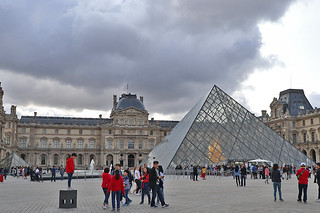

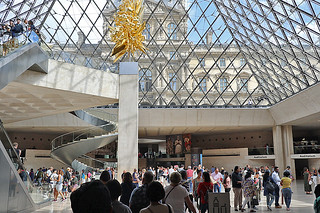



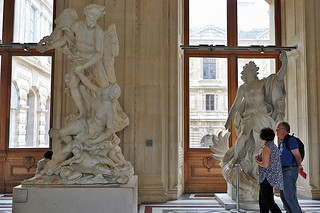



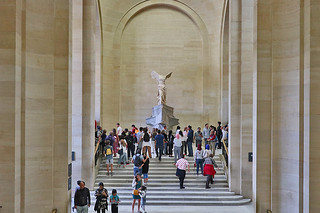
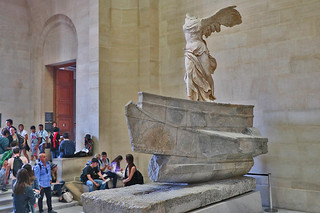
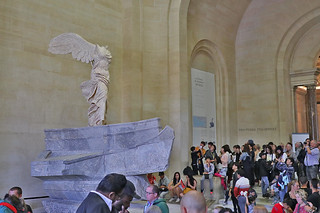
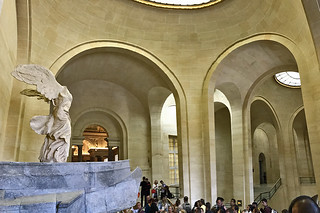
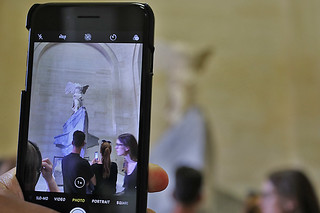
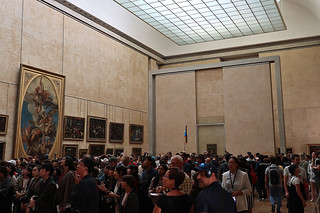
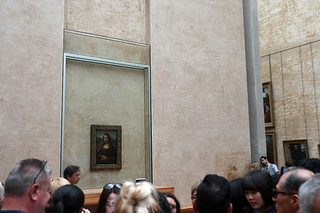
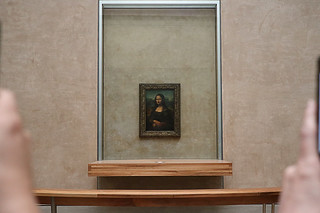
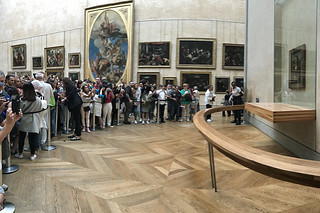
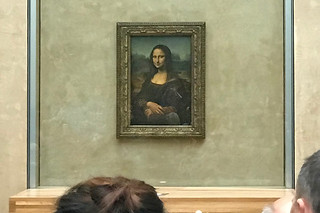
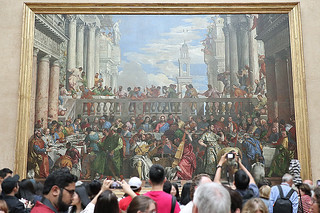
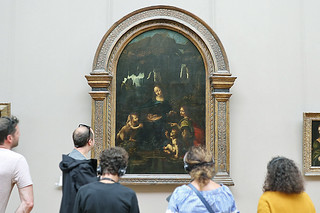
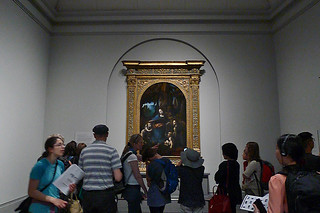
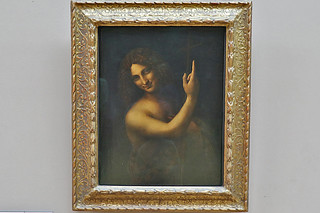
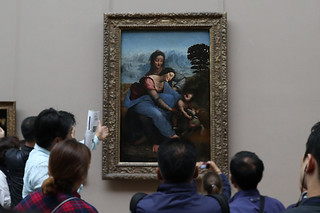
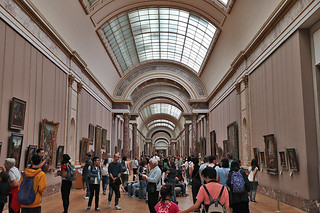

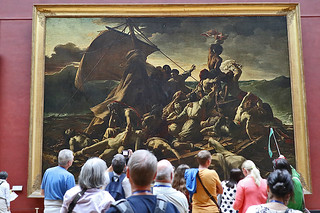
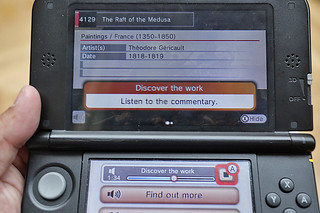
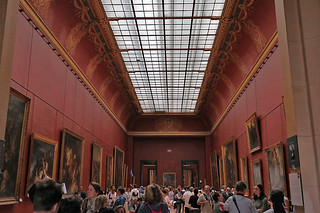
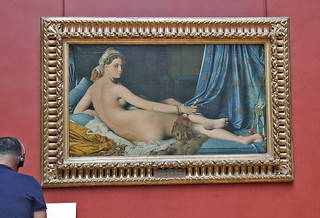
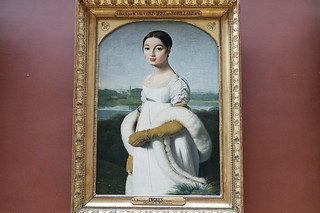
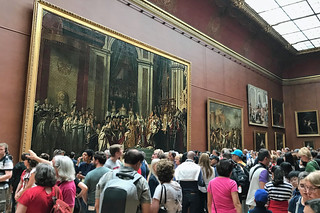
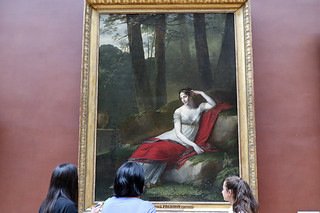
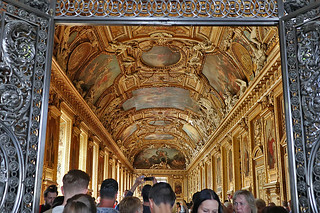

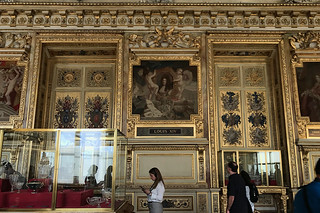
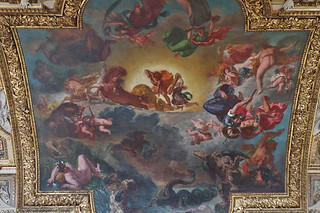
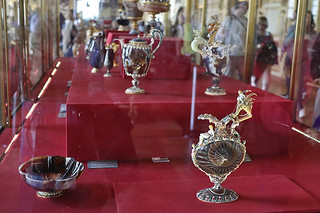

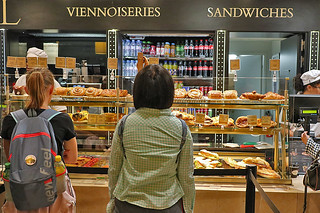
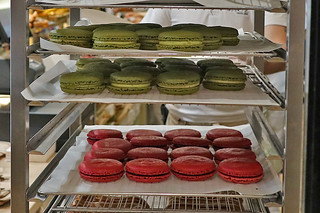
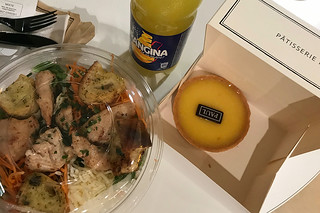

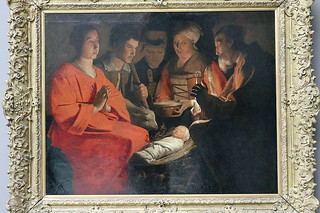
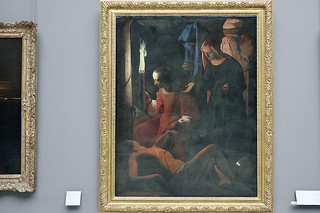


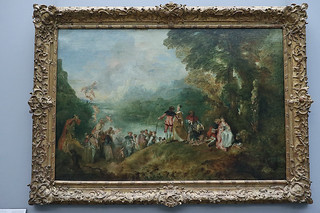

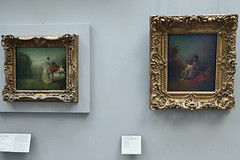
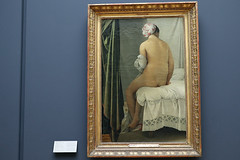

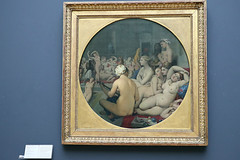
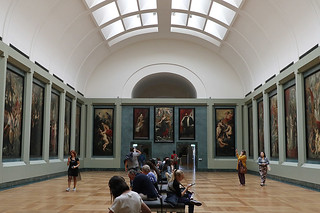

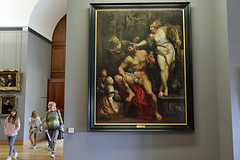


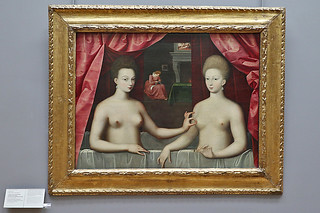
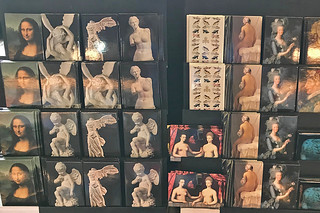
No comments:
Post a Comment